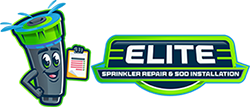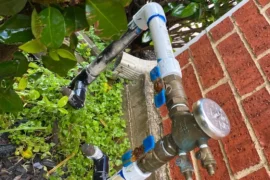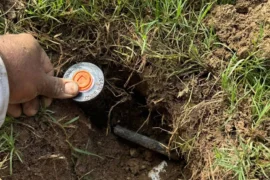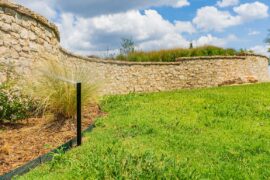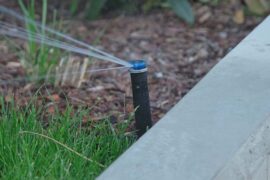How do you ensure enough water coverage for your lawn? Your sprinkler system should have adequate water pressure to cover the area efficiently. Sprinklers with poor spray systems may cause dry patches.
At first, check your water supply source. Do you use well water or city water? City water pressure is 40-80 PSI, which is higher than that of well pumps, whose pressure is typically limited to 30-50 PSI. Get a pressure gauge and attach it to the outdoor faucet. If the pressure is below 40 PSI, the sprinkler may struggle to cover the lawn.
There are some reasons leading to low water pressure. The water line could be narrower than usual, and your pressure regulator may not function properly. Do not worry; you may not have to hire a technician.
Troubleshooting low water pressure hurdles
First, check why your sprinklers are sluggish. A leaky pipe or a clogged filter often leads to weaker flow. Check your sprinkler heads for accumulated sediment, dirt and, debris.
Unscrew each sprinkler head and rinse it under the faucet. Check for any grass clippings and sand. If this fails, look into the water meter for invisible leaks. If the meter spins when everything is off, there may be leaks under the ground. Fixing a leak can increase water pressure by 10-20 PSI.
The pressure regulator could also be a problem! Your sprinklers may suffer if it is set too low. Carefully use a screwdriver to adjust it. With most sprinkler setups, a pressure of 50-70 PSI is sufficient.
Upgrading your water line for a better flow
A sluggish water line will restrict your sprinkler system. In older homes, pipes have ½-inch diameters, which are inadequate for modern irrigation needs. Switch to a 1–inch line to experience an increased water volume.
Check the current pipe diameter using a ruler. If it is below ¾-inch, hire a plumber for the replacement. PVC pipes offer a good mix of affordability and durability. Larger pipes help improve water flow and pressure. Also, check whether your water meter is suitable for the upgrade.
Using a booster pump for pressure boost
To override the issue of a weak water source, set up a booster pump. They are ideal for low-PSI city lines and well water. However, they do not come cheap.
Select a pump with the right horsepower for your sprinkler system. For small yards, a ½ HP pump will suffice, while larger setups may require a 1 HP unit. Set it up near your water main and the link it with a pressure tank for a better flow.
High-quality booster pumps can increase pressure by 20-40 PSI. That should instantly transform your slow sprinklersinto lawn-soaking performers. Always, check your local codes and whether permits are required for pump installation.
Fine-tuning sprinkler heads to improve coverage
Your sprinkler heads may need an adjustment, as not all heads are the same. Rotary heads throw more water than spray head types, more so when pressure crosses past the level of 50 PSI. Throw away any older spray heads.
Check your sprinkler nozzle size carefully. Smaller nozzles with 1.5 GPM capacity focus the water, while larger ones with 3 GPM or more spread it over a wider area. Match your nozzles to the available water pressure. Mismatched nozzles can water wastage and cause dry patches.
Make sure you do not overcrowd your zones with too many heads in one area. This reduces pressure and sprinkler performances. Keep 4-6 sprinklers for one zone. To ensure the required pressure in each zone, use a new valve and the split your zones.
Maintaining your irrigation system for a steady pressure
A neglected sprinkler system quickly loses pressure, just like a flat tire loses air. It works better with regular maintenance. Clogged filters can reduce pressure by up to 15 PSI, so inspect them monthly.
Flush your lines annually in spring to remove sediment. To do this, remove the main valve and allow water flow for some time minutes. If you use well water, install a sediment filter to effectively remove junk.
Before winter, use an air compressor to thoroughly clear the lines. Trapped water may freeze, cracking the pipes with pressure, causing leaks. This helps you reduce the risk of freeze damage.
Using smart controllers to obtain better pressure
Smart controllers can optimize your sprinkler system and improve pressure regulation. High-end units come with advanced features like weather-based scheduling and better watering.
Set the controller device to cover one zone at once. Running multiple zones simultaneously will reduce the pressure available to each head. Smart controllers have flow sensors to detect leaks and alert users.
Most smart controllers will need Wi-Fi and they cost above $100. They will help you save around 8,800 gallons of water yearly, managing overall system strain better. Invest in a rain sensor device to control watering during the rainy days.
When should you hire a professional for sprinkler problems?
Sometimes, you will need professional help to tweak your sprinkler system. Veteran Irrigation specialists and plumbers can troubleshoot complex issues better. They come equipped with the right tools, apt skill sets and experience.
They may charge $50 or more per hour, depending on your region. These professionals can handle complex tasks such as setting up a backflow preventer and rerouting pipes with ease.
Check online reviews before you contact these experts. Some contractors may add unnecessary repairs. Trusted ones will thoroughly inspect your system and provide a transparent estimate with no hidden costs.
